We have mentored dozens of UX practitioners and grad students over the years, and we have found that what most mentees are looking for is coaching or advice. The questions they have fall into categories such as, “Do I need a degree in UX?,” “What classes should l take?,” “How can I get my first UX job?,” “Should I be a generalist or a specialist?,” and “Should I move into management?” These kinds of questions can often be answered in one or two meetings, and then the mentees are off and running.
Traditional mentoring programs have a lot of value. But finding the mentors can be difficult, and then pairing them one-by-one with mentees can be time-consuming. Because the recruiting and matching processes are such a heavy lift, the number of mentees who can be paired with mentors is always limited to the maximum number of mentors. Many potential mentees are left without mentors.
In this article, you will learn about the following:
- how we created rapid group mentoring activities
- how we organize the mentoring activities so mentees and mentors get the most out of the time they have together
- all the details of logistics and recruiting, so you can organize a similar activity in your UX community
Mentoring at UX Conferences
Since 2013, we have organized group mentoring sessions at the annual UXPA Boston Conference, which typically takes place in May of each year, as well as the UX Fair, which typically takes place in November to coincide with World Usability Day. Each conference has a different purpose and is geared toward different audiences. The UXPA Boston Conference is an annual, one-day conference that attracts a variety of people across disciplines: newcomers to our field and experienced practitioners, as well as distinguished professionals who have been defining and shaping the field of user experience for decades. The UX Fair is an annual, one-day career development and mentoring fair for students and career changers who are interested in breaking into the field of user experience.
We have conducted some one-on-one mentoring events, pairing mentors and mentees for one-on-one sessions. The upside is that it allows for a personalized meeting between an experienced professional (the mentor) and the mentee. But the downsides with this approach involve sign-ups and scheduling in advance, sending reminders to both parties, and rescheduling if mentors or mentees do not show up or cancel. It can work, but it also can be a logistical headache. You also run the risk of pairing the wrong mentor with a mentee.
Group Mentoring
Instead of individual, one-on-one sessions with mentors and mentees, we schedule Group Mentoring tables at UXPA Boston’s two annual conferences. At the all-day UXPA Boston Conference, we run two Group Mentoring sessions, one in the morning and one in the afternoon, in parallel with other conference sessions. At the all-afternoon UX Fair, we run at least one Group Mentoring session each year; in 2017, we ran two. Each Group Mentoring session lasts an hour.
We really stumbled on this approach, and it took a little trial and error to get it right. In 2012, the first mentoring activity at the UXPA Boston conference was very unstructured. We recruited mentors (mostly people we knew) and asked them to show up for mentoring at a specific time. We had no idea who or how many mentees would show up. The response was overwhelming, and we had far more people looking for mentoring than we had mentors. While some mentors paired up with a single mentee, three groups organically formed, making a circle of chairs to include one or two mentors and several mentees. What we observed was that (a) many mentees had the same questions and (b) mentees said they got a lot out of hearing other peoples’ questions and the mentors’ answers to them. Ta da! Group mentoring was born.
The next year, we scheduled a room with round tables, like you see in Figure 1. We tried to organize mentees (and mentors) into groups of people who either identified as “User Researchers” or “Designers,” but there were people who showed up who were not in the UX field, as well as people who were working independently. The following year, we tried categorizing the mentoring tables by something like “Independent,” “New to UX,” and “UX Practitioners.” We had almost no independent practitioners and more demand for “New to UX” than we could meet.
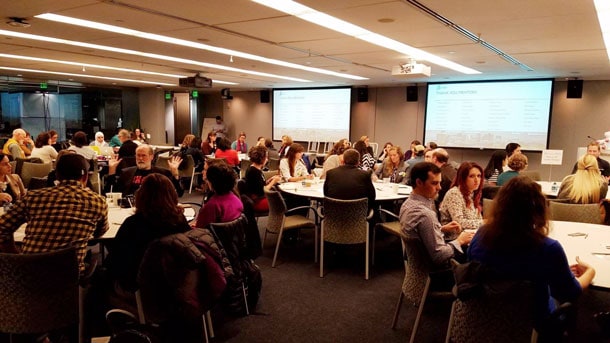
So, for the past four years, we have focused on mentoring people in two categories, which has worked really well. The first category is made up of people who are new to UX, and this is where we see most of the demand. The second category is UX professionals who are interested in career development. The “New to UX and Career Changers” category includes students and professionals working in other fields who are interested in getting their first job in user experience design, research, information architecture, or content strategy. The “Career Development” category focuses on UX professionals already working in the field who are looking for advice on how to get buy-in for their work, how to engage stakeholders, or how to get a promotion to the next level. We see both individual contributors and managers attend these sessions. The categories work well for two reasons. First, it is pretty easy for mentees to select one category or the other. And second, we see the types of questions that people ask are more related to where they are in their UX career than what particular type of role they have.
How the Group Mentoring Sessions Work
When the mentees arrive, we ask them what kind of advice they are looking for, and then they are given color-coded index cards: one color for the “New to UX and Career Changers” folks (like the one shown in Figure 2) and another color for the “Career Development” folks. When they are given the card, they are directed to a table that has a sign on it, indicating the type of mentoring they are looking for. The mentees are asked to complete the cards as soon as they sit at the table. On one side of the card, there is a place for mentees to write three things: First Name, Current Role, and one question [they] would like answered today.
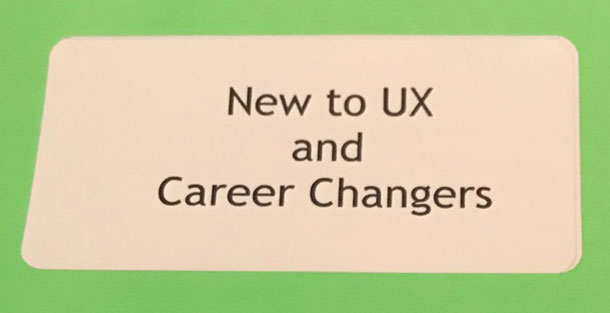
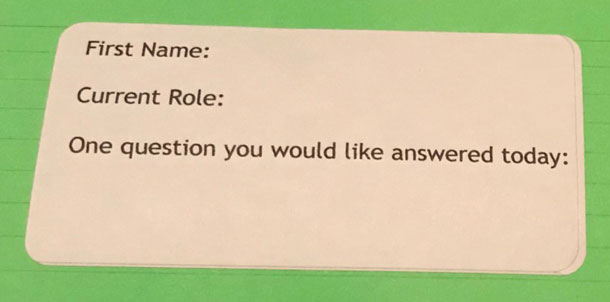
The cards serve three purposes. First, all mentees should have the same color card, which indicates what kind of mentoring they are looking for, so mentors can quickly see if anyone is at the wrong table. Second, it gives the mentees something to do while their table is filling up. But third, and most importantly, it allows mentees to crisply identify what they want to ask so they are able to make the most efficient use of the group’s very limited time.
Once the table is full (two mentors and about eight mentees), each mentor spends about 30 seconds introducing themselves: first name, current role, degree(s), and years in the UX field. Then, each of the mentees spends 30 seconds reading what they have written on the cards. It gives mentors an overview of who they are talking to, what their questions are, and in what order they want to answer them. We find there are always multiple people with the same question, so we recommend mentors start with those first. Both mentors then contribute their thoughts on each question, but can alternate who goes first. Once mentors think they have answered all of the questions, they ask the mentees if they have answered everyone’s question. If so, they ask for other questions.
The following are typical questions that mentees new to the field ask:
- How do I break into the UX field?
- How can I get into a UX role at my current company?
- What skills are hiring managers looking for?
- Do I need a master’s degree? Certification?
- Do I need a portfolio? If so, how do I set it up? What do I put in it?
- I want to be a designer. Do I need to know how to code?
Recruiting Mentors
We have recruited mentors over the years through networking, usually on LinkedIn, Facebook, and Twitter—but also through face-to-face interactions by reaching out to colleagues, former classmates at alumni reunions, or chatting people up at conferences. We tag UX friends on Facebook and send emails directly to individuals. That approach is effective at recruiting people who have mentored before and who would like to mentor again.
The other approach we use, which is effective at recruiting new mentors, is setting up online surveys in Wufoo (like the one in Figure 4) and sending out email blasts to our UXPA Boston membership using Mailchimp (shown in Figure 3). Both approaches are necessary because we need both experienced mentors, as well as new mentors.
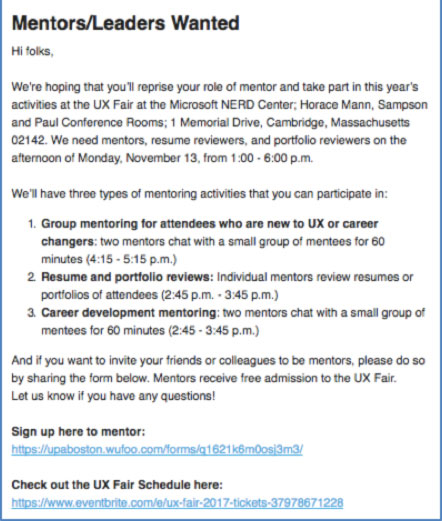
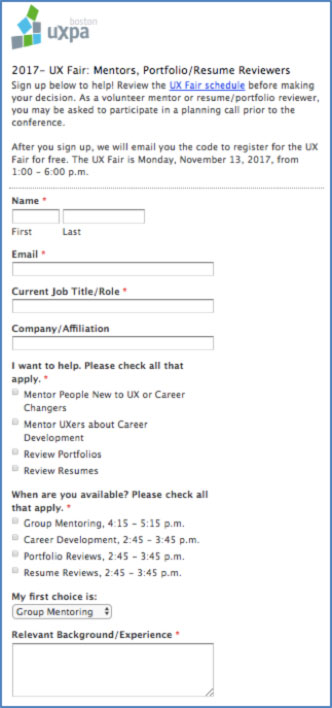
We have used a Mailchimp-generated newsletter (Figure 5), as well as Facebook and Twitter posts (Figure 6 and 7), to recruit mentors and to advertise mentoring events and conferences.
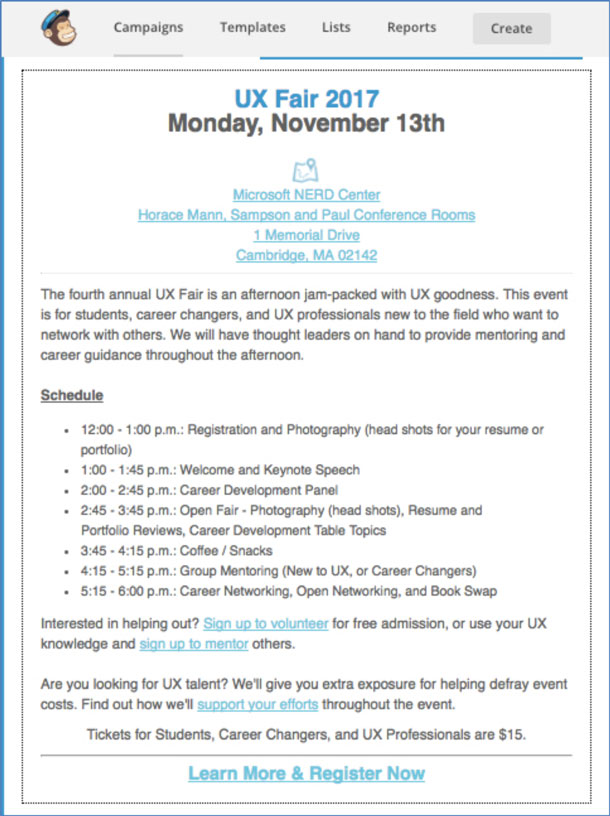
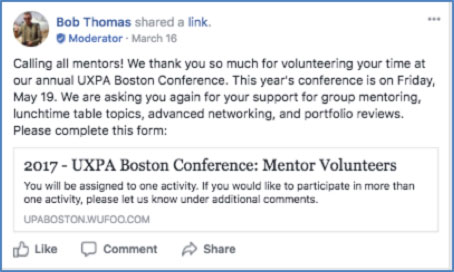
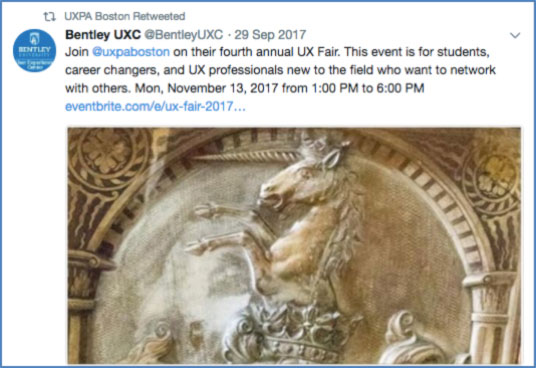
Numbers of Mentors to Recruit and Number of Mentees to Prepare for
The UXPA Boston Conference has been averaging 925-1,026 attendees the past four years (2015-2018). We plan for 50-60 attendees at each Group Mentoring session. Even though there are four to five other conference sessions going on at the same time, our mentoring sessions are popular for those attendees who are new to UX or seeking a new career in UX. With 50-60 attendees, we need to organize eight tables, of which five to six are for “New to UX and Career Changers” and two to three are for “Career Development.” We staff two mentors at each table, assuming that they will be seated with 5-10 mentees. We typically recruit 16-20 mentors for 50-60 mentees. We also schedule alternate mentors in case some of the mentors cannot make it. When mentors can’t make it, it is usually because of an illness, and they email us to profusely apologize for missing out on the experience.
The UX Fair has been averaging 100 attendees the past few years (2015-2017). We plan for 70-80 attendees at a Group Mentoring session. No other sessions are going on at the same time. That means we need to organize 10 tables, of which seven to eight are for “New to UX and Career Changers” and two to three are for “Career Development.” Consistent with the UXPA Boston Conference, we staff two mentors at each table, assuming that they will be seated with 5-10 mentees. For this conference, we recruit 20-24 mentors, which includes three to four alternates to replace mentors who may need to cancel at the last minute.
Pairing Mentors
After we recruit the mentors, we need to ensure that we have enough mentors in the right time slots for the right topics so every table is staffed. We try to pair a more experienced mentor with a less experienced one, and also try to pair one female and one male mentor at each table to ensure that the mentees get different perspectives on their questions. To pair mentors, we first export the “call for mentors” survey data from Wufoo-completed forms. Once we have paired the mentors, we email them to let them know who they will be working with and to give them guidelines on how to run the sessions. This advance notice gives the mentors the time to ask any questions they have, as well as (occasionally) ask to be paired with another mentee.

How to Prepare for and Facilitate the Group Mentoring Sessions
As discussed earlier, we like having mentors and mentees meet in a circle, so we book rooms with round banquet tables that can each seat 10-12 people. But any arrangement that allows all the participants to see and hear each other could work. We use table stands that hold laminated 8 ½” x 11″ signs to identify the mentoring topics at each table.
We pre-label two different color-coded index cards: “New to UX and Career Changers” on green cards and “Career Development” on yellow. You do not have to use labels, but it saves a huge amount of time and effort on your part. On the back of the cards, we have our mentees fill out their first name, current role, and one question they would like answered. It helps to break the ice and organize the discussion.
Volunteers to Assist Participants to the Right Table
We recruit two to four volunteers/facilitators at each session to ensure that the mentees—and the mentors—know which tables to go to. In most cases, mentees will flock to a “New to UX and Career Changers” table. But some may need to be directed to a “Career Development” table.
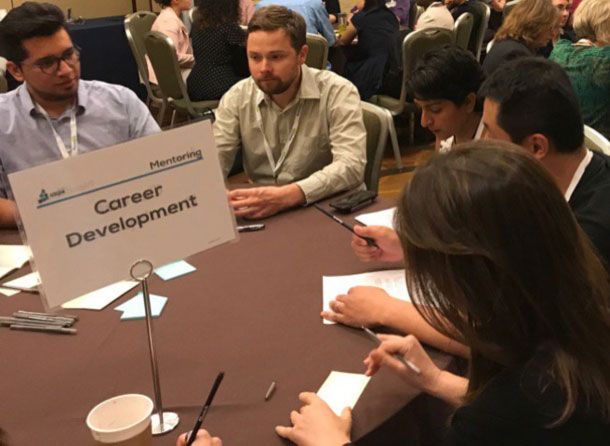
Getting Feedback: Following Up the Group Mentoring Sessions
To help improve our group mentoring sessions, we ask our mentors to complete a short survey after the sessions are over, so we can fine-tune the activities over time. For example, when we first started running the sessions, some of our mentors told us that they did not know how to get the conversation started. The next time we ran the sessions, we included the index cards where mentees could write their first name, current role, and one question they would like answered.
Conclusion: The Benefits of Mentoring
In a good mentoring relationship, even one that lasts only 60 minutes, both people benefit. The person being mentored gains something that has a perceived value. The mentor has a chance to give back knowledge that they often did not know they had or thought would be valuable to another person. We have heard from mentors that they attend these conferences just because they enjoy the mentoring so much. And we have received unsolicited feedback from mentees that the advice they have received at these events has changed their lives and careers.
One of the most important points about mentoring is that “perspective is additive.” We all have a unique way of thinking, and we all have different experiences to draw on. So as mentors it is upon us to add other people’s perspectives into this big UX mix.
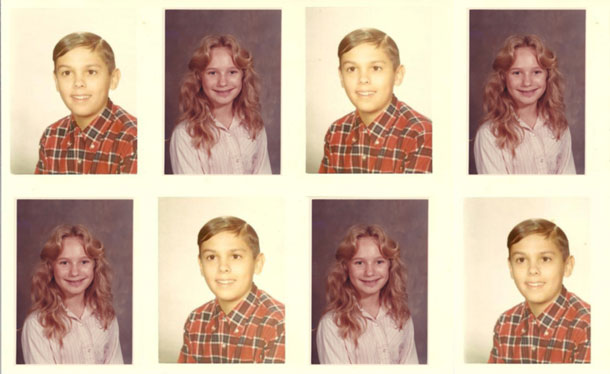
Because let’s face it—we can’t make carbon copies of ourselves. As a UX community, we all benefit in celebrating differences. For example, in the field of usability research, some people want to try new methodologies, while others master tried-and-true methods. Through these mentoring programs, we are enabling both mentors and mentees to share their unique points of view with one another. This collective perspective creates better outcomes. None of us would be where we are today without our experiences as both mentors and mentees.
